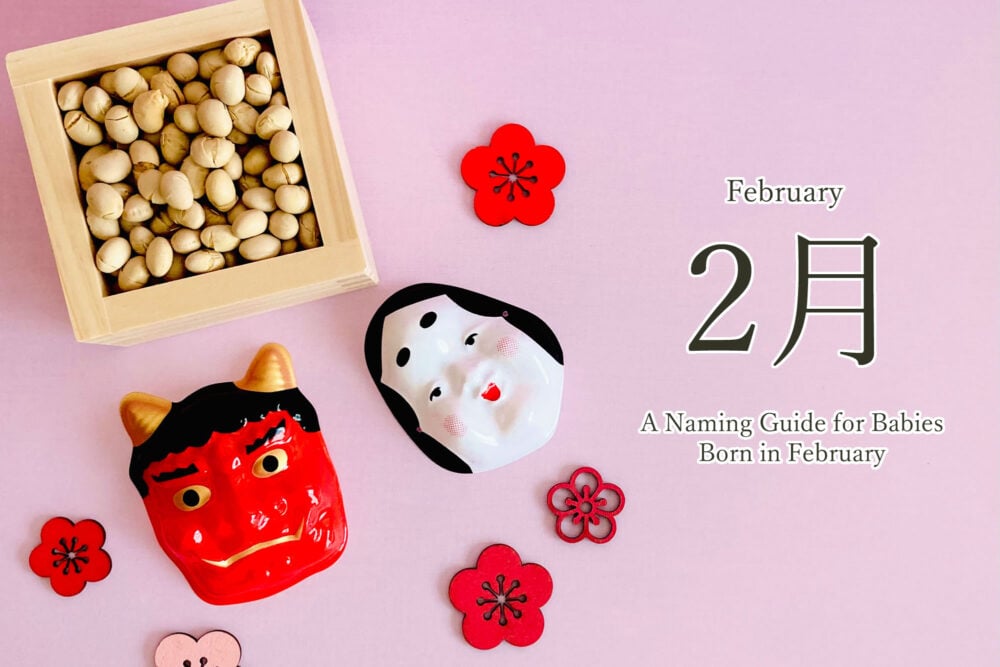Share on your favorite
Or copy the link
Below are navigation links that will take you to the main text and navigation menus.
26,551 first names, 70,620 last names, 333,585 kanji variations.
one of the best Japanese name search tools for your baby!

February in Japan is a special month that bridges winter’s lingering chill and the first signs of spring’s renewal. From the traditional bean-throwing festival of Setsubun to the romantic atmosphere of Valentine’s Day, February holds a wealth of inspiration for baby names. In this article, we explore meaningful kanji, motifs like plum blossoms and camellias, and unique naming ideas that capture the essence of February’s transition from cold to warmth.
Contents
February in Japan is a unique “in-between” month: winter’s chill still lingers, yet the calendar marks the beginning of spring (around February 4th, called “Risshun”). This is also a month of meaningful events:
A baby born in February can be given a name that reflects the transition from cold winter days to the gentle promise of spring. In this guide, we’ll introduce motifs and meaningful characters (kanji) that resonate with February’s spirit, along with plenty of examples for boys, girls, and gender-neutral names.
Below are some popular or meaningful characters you might incorporate into a name. Each symbolizes part of February’s transitional nature or spirit:
Below are sample names grouped by boys, girls, and unisex. Keep in mind that in Japanese naming, the same kanji can often be read in multiple ways, so these are just suggestions.
February stands out as a month of intersection—winter’s end, spring’s soft beginnings, and events like Setsubun or Valentine’s Day. By weaving in references to plum blossoms, leftover snow, or the subtle lengthening of daylight, you can craft a name that resonates with February’s gentle transitions.
Whether you select a name highlighting the pure chill of snow or the hopefulness of budding flowers, a February-born child’s name can capture the essence of anticipation, new life, and cherished traditions. We hope these ideas and examples guide you toward a name that celebrates the season when winter meets spring—and, of course, a lifetime of warmth and happiness for your little one.
Sort by: Most Kanji Variations
Sorts names by how many different kanji spellings they have. In general, names with more variants tend to be more familiar and widespread in Japan (with some exceptions).
Sort by: Most Viewed
Sorts names by page views on this site. Views reflect global traffic (including Japan), so this does not represent popularity among Japanese people only. A high view count does not necessarily mean the name is famous in Japan.
What is Hiragana?
Hiragana is one of the two Japanese syllabaries. Each character represents a sound (mora), not a meaning. It is used for native words, grammatical particles, verb/adjective endings (okurigana), and to show pronunciation above kanji (furigana). It developed from cursive forms of kanji.
What is Katakana?
Katakana is one of the two Japanese syllabaries. Each character represents a sound (mora), not a meaning. It is mainly used to write foreign words and names, loanwords, onomatopoeia, and for emphasis.
What are English Syllables?
A syllable is a unit of pronunciation in English — it’s the beat you hear when you say a word.
Here are a few quick examples:
cat = 1 syllable
ba-by = 2 syllables
beau-ti-ful = 3 syllables
On this site, English Syllables show how a name naturally breaks into sounds when spoken in English. This helps you understand how English speakers naturally say the name and where they pause between sounds.
What are Japanese Morae?
A mora (plural: morae, Japanese: 拍 Haku) is the basic unit of sound in Japanese — think of it as one rhythmic “beat” when speaking.
Here are a few quick examples:
あ (a) = 1 mora
あい (a-i) = 2 morae
きょう (kyo-u) = 2 morae
On this site, Japanese Morae show how many “beats” a name has in Japanese. Most Japanese names have about 2–4 morae, which affects how natural and rhythmic the name sounds to native speakers.
This helps you see how the name fits into the natural rhythm of Japanese speech.
What is English Transcription?
“English transcription” (romanization) is the romanized form of a Japanese name, intended to reproduce its pronunciation as closely as possible. It is also useful for searching names on this site.
Japanese-Style Nicknames
In Japan, nicknames are used to express familiarity and affection. Typical features include:
Shortened forms: Names are often shortened for closeness, e.g., “Yuki” from “Yukiko” or “Taka” from “Takashi”.
Suffixes: Terms like “-chan” (often for girls, also for young children) and “-kun” (often for boys) are used among family and close friends. Among very close adults, “-chan” may still be used. More details
Use & context: Nicknames are informal—common among friends, family, or close colleagues—and are not suitable for formal or professional settings. Their use implies a certain degree of intimacy.
Long vowels: The long vowel mark “chōonpu” (ー) extends the preceding vowel. For example, “あーちゃん” (A-chan) lengthens the “あ” sound.
Households
Sorts surnames by the estimated number of Japanese households that use them. More households generally indicates a more common or well-known surname.
About our last-name data
